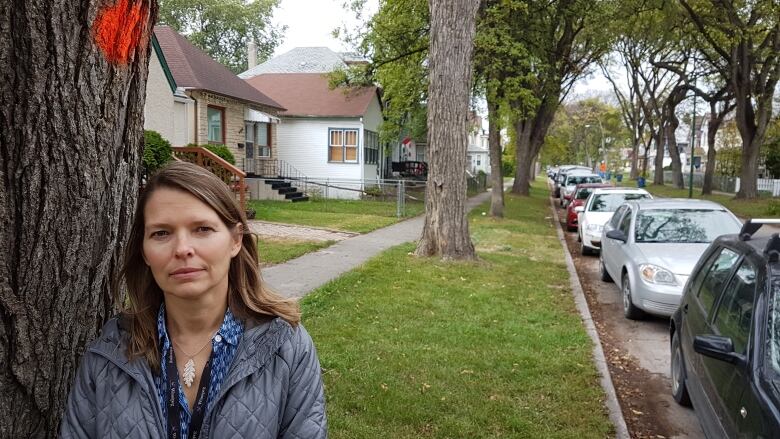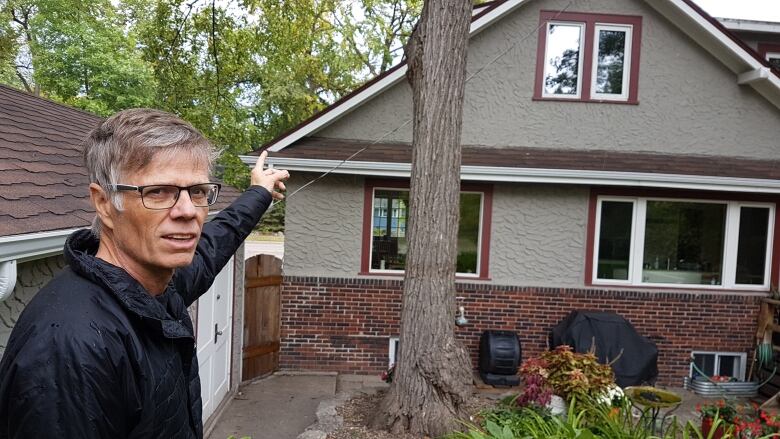More elms marked for death right now than have been in Winnipeg for 20 years
Dutch elm removal reaches 'critical point' as city confronts backlog of diseased trees, city forester says

There are more trees marked for death right now than Winnipeg has seen since the mid-1990s, and the city's forester saysthe backlog of infected elms is helping Dutch elm disease spread.
"Basically we just don't have enough resources to keep up with these high numbers," Martha Barwinskysaid.
"We've reached a critical point in the management of Dutch elm now, and definitely we need to get this backlog dealt with."
At about 230,000 individual trees, Winnipeg is home to the largest population of American elms in North America.
Each point on the map represents an elm tree that was cut down in 2014 due to infection from Dutch elm disease.
The city's forestry branch estimates there will be 8,321 trees tagged with those ominous orange dotsby Sept. 30 including 821 that were marked in 2015 and 2016 and still haven't been cut down.
"Generally, the removal season starts mid-October and runs through to May but for the past two years, we have been removing Dutch elm-diseased trees year-round to catch up," a city spokesperson said.
The forestry branch was alotted $4.28 million dollars to fight Dutch elm this year. Barwinskysays the annualbudget usually allows for the removal of about 3,500 elms per year, which is why the forestry branch recently applied for additional funding.
Last week, the city's standing policy committeeapproved a proposal to direct$380,000from the forestry branchcapital budget toward the Dutch elm removal program for the remainder of the year. The extra funds will help the city take out 447 additional diseased elms, bringing the estimated number of trees removed this year to 6,547.
Even with the extra funds,the branch is projecting to overspend by $680,000 by the end of this fiscal year and still won't totally get the city caught up on the trees waiting to be removed previous years.
"We need to stop the spread, we need to clean up that backlog and then we need to get the currently marked trees out in a timely manner," Barwinsky said.
'Lose a sense of place'
Retired CBC broadcaster John Drabblesaid he thinks the problem is going to get worse before it gets better.

At this rate, he fears future removal costs could overrun the city, and he worries more of the expensescould getpassed on to homeowners.
This month Drabblewatched city crews tag 10 elmsand haul away several othersfrom his and neighbouring lawns inthe Kingston Crescent area of St. Vital.
"Our tree looked fairly healthy but they said it was diseased, andmy feeling was they might as well letit go now while the city crew is here than wait for it to die," he said.
"These trees were planted before this house was built."
Boulevards and lawns in the riverside neighbourhood are lined with elms, but the canopy is getting thinner every year, Drabble said.
"You had a concept of what your neighbourhood was like in your mind. Now it's completely changed," he said."It's a bit disorienting in a way. You just lose a sense of place."
Monocultures at risk
The hardest hit areas are often parks andboulevards, where the city planted its monoculture of elms decades before the disease arrived in Winnipeg in 1975.
A moratirum was placed on planting elms after the disease arrived, so the city set off planting another monoculture, this time of ash trees.
The 2,000 dots on the map below are a random sample of Winnipeg's green ash trees, the second-most common tree in the city. The data reveals although the tree was widely planted across the city, there are high concentrations in newer neighbourhoods, whichexperts say are likely to become the problem areas should the emerald ash borer appear in Winnipeg.
The problem is that when you plant a bunch of one species in an area the trees become more susceptible to disease, which is why elm-heavy areas such as the West End, Wolseley and River Heights are among the worst areas for infected elms, Barwinsky said.
The city has been planting a more diverse stock of species in the past decade as a future safeguard, and working with local tree nurseries to do the same.But that diversity might not provide much of a shield when emerald ash borer beetles invade and they are coming, Barwinsky said.
The Asian beetle has been observed as near as Thunder Bay and Minnesota in recent years.
"We are no longer planting ash trees at this time as we prepare for the incoming emerald ash borer," Barwinsky said. "It will be a significant loss of our canopy.
"With emerald ash, we know that there willbe significant losses and we are just managing mortality. With the elms, we know that we can preserve them."
Early ID system
The city partnered with a team of students and researchers this summer to develop a more precise way of identifying brood trees earlier in the cycle of infection. It's still early days and they're only now starting to pour over the data collected this year, Barwinsky said.
The city played an advisory role in a previous five-year study by the University of Manitoba and what was then Manitoba Conservation. The rapid removal effortset out to identify infected trees and remove themthe same year in a handful of neighbourhoods.
They found new generations of elm bark beetles, which carry the disease from tree to tree,takeflight at the end of summer. The team managed to cut elm infection rates in half by identifying brood trees and destroying them before the beetles emergedenmasse and spread the fungus to other trees, Barwinsky said.
Butdue to funding restrictions, it's been next to impossible to replicate that method on a mass scale.
"Realistically here with so many thousands of trees, we can't really have a true rapid removal program, but we could have a modified form of that program where we could reduce the insidence of disease," Barwinsky said.
'Be wary'
City crews and contractors are monitored to ensure tools are sterilized regularly so they don't unwittingly spread the disease from tree to tree,Barwinskysaid.
But there are things residents can do to stem the spread.
The city has already found 300 log piles in yards this year that contained elm, Barwinsky said.
"In the past we've actually seen outbreaks of Dutch elm disease in an area where there has been an elm firewood pile that hasn't been disposed of," she said, encouraging Winnipeggers to reportsuspicious firewood or log piles to 311.
"Be wary of where this firewood is coming from."

Corrections
- A previous version of this story stated the City of Winnipeg's Dutch elm disease removal program ends Sept. 30. In fact, the removal period typically runs from mid-October through May, but city crews have been cutting down infected trees year-round in the past two years to catch up with a backlog.Sep 25, 2017 10:42 AM CT













_(720p).jpg)


 OFFICIAL HD MUSIC VIDEO.jpg)
.jpg)



























































































